You’ve probably experienced that unsettling feeling when you’re away from home, wondering if everything’s secure. Motion sensor notifications can transform that uncertainty into confidence by instantly alerting you to any unexpected activity on your property. Whether it’s a potential intruder, a package delivery, or simply monitoring your pets, these smart systems offer real-time awareness that traditional security methods can’t match. But choosing the right notification setup requires understanding several key factors.
Understanding Motion Sensor Technology and Detection Methods

When choosing a motion sensor for your security system, you’ll encounter several detection technologies that work in fundamentally different ways.
Passive Infrared (PIR) sensors detect heat signatures from warm bodies, making them ideal for indoor use while remaining energy-efficient and budget-friendly.
PIR sensors offer an ideal balance of affordability and efficiency for indoor security applications.
Microwave detection methods cover larger areas and resist environmental factors, perfect for outdoor applications despite higher costs.
Ultrasonic sensors use sound waves for precise motion detection, though temperature and humidity can affect their performance.
For maximum reliability, dual-technology sensors combine PIR and microwave technologies, requiring both systems to trigger before activating alarms.
This dual approach notably reduces false alarms while maintaining thorough coverage, ensuring you’ll receive accurate notifications when genuine motion occurs.
Real-Time Alert Capabilities for Enhanced Home Protection
When motion sensors detect movement on your property, you’ll receive instant notifications that enable immediate response to potential threats.
Your smartphone becomes a direct link to your home’s security system, delivering real-time alerts whether you’re at work, traveling, or simply in another room.
This instant threat detection capability transforms your mobile device into a powerful security tool that keeps you connected to your property’s safety 24/7.
Instant Threat Detection
As soon as movement is detected on your property, motion sensors instantly transmit real-time alerts directly to your smartphone, creating an immediate line of defense against potential threats.
This instant threat detection capability transforms your home protection strategy by eliminating the delays that traditional security systems often experience. When unauthorized movement occurs, you’ll receive notifications within seconds, allowing you to assess the situation and take appropriate action immediately.
The speed of these real-time alerts is vital during security incidents. Every second counts when protecting your family and possessions.
Motion sensors don’t wait for confirmation or verification – they detect movement and notify you instantly. This rapid response system guarantees you’re always informed about what’s happening at your property, whether you’re at work, traveling, or simply in another room.
Mobile Alert Integration
Mobile alert integration seamlessly connects your motion sensors to your smartphone, delivering critical security notifications wherever you are. You’ll receive real-time notifications instantly when sensors detect unusual activity, enabling prompt responses to potential security threats. Advanced sensors differentiate between human movements and pets, dramatically reducing false alarms while ensuring alerts remain actionable.
Your smart home systems can automatically trigger additional security measures when motion’s detected, like activating cameras or lighting to deter intruders. Studies demonstrate that properties with real-time alert capabilities experience fewer burglaries.
| Feature | Benefit | Impact |
|---|---|---|
| Instant Alerts | Immediate notification | Quick response time |
| Pet Detection | Fewer false alarms | Relevant alerts only |
| Remote Monitoring | Monitor from anywhere | Enhanced flexibility |
| Camera Integration | Visual verification | Better threat assessment |
| Lighting Activation | Automatic deterrent | Increased security |
Customizable Notification Settings for Different Home Modes
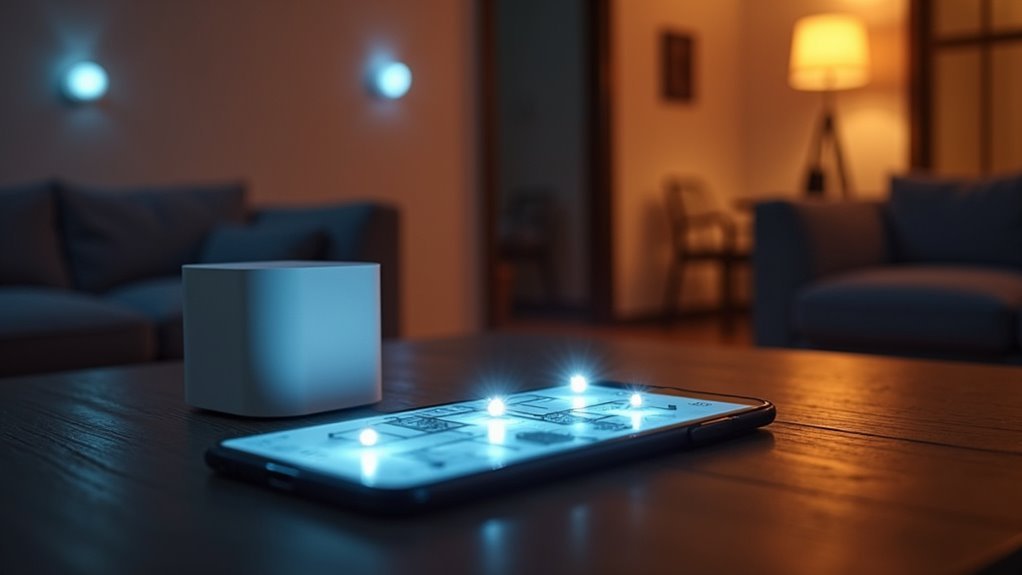
You can tailor your motion sensor alerts to match your daily routine by configuring different notification settings for each home mode.
When you’re in “Home” mode, you might want to disable indoor motion alerts to avoid constant interruptions, while “Away” mode can trigger all sensors to keep you informed of any activity.
These customizable options let you fine-tune which sensors send alerts and when, ensuring you only receive notifications that matter for your current situation.
Home Mode Settings
Three distinct home mode settings enable you to fine-tune motion sensor notifications based on your current status and security needs.
In Home mode, you’ll disable motion alerts from routine movements like pets or family members while maintaining security monitoring.
Away mode activates notifications immediately, ensuring you’re alerted to potential intrusions when you’re not present.
These customizable settings let you select which sensors trigger notifications in different modes, enhancing your security experience by focusing on vulnerable areas when needed.
You can designate specific zones for each mode, preventing unnecessary alerts during daily activities.
This automated control streamlines your experience and minimizes alarm fatigue, addressing what many users have specifically requested for their motion sensor notifications.
Alert Customization Options
Building on these mode-based controls, alert customization options give you granular control over exactly how and when you receive notifications. You can tailor motion sensor notifications to match your specific lifestyle and security needs.
These customization features dramatically improve your user experience by eliminating unnecessary alerts that previously caused frustration. You’ll maintain peak security vigilance without being overwhelmed by constant notifications during routine activities.
The system lets you filter out false alarms from pets or regular household movements while ensuring genuine security threats reach you immediately. You can customize notification types, timing, and delivery methods for each security mode.
This intelligent approach balances your need for thorough protection with daily comfort, preventing alert fatigue while keeping your home secure.
Integration With Smart Home Devices and Automation Systems
When motion sensors connect with your smart home ecosystem, they transform from simple detection devices into powerful automation triggers that orchestrate your entire living environment.
These motion sensors seamlessly integrate with smart home devices, creating sophisticated automation systems that respond intelligently to your presence. When you enter a room, lights automatically illuminate while thermostats adjust to ideal temperatures, delivering remarkable energy efficiency.
| Integration Type | Automated Response |
|---|---|
| Lighting Control | Automatic on/off based on occupancy |
| Climate Management | Temperature adjustments for comfort |
| Security Cameras | Real-time recording and alerts |
| Door Locks | Automated locking sequences |
Your security notifications become more sophisticated through these connections. Modern sensors distinguish between human movement and pets, reducing false alarms. You’ll customize alert settings based on your home’s current mode—whether you’re home, away, or have the system disarmed—ensuring relevant, timely notifications.
Mobile App Connectivity for Remote Monitoring
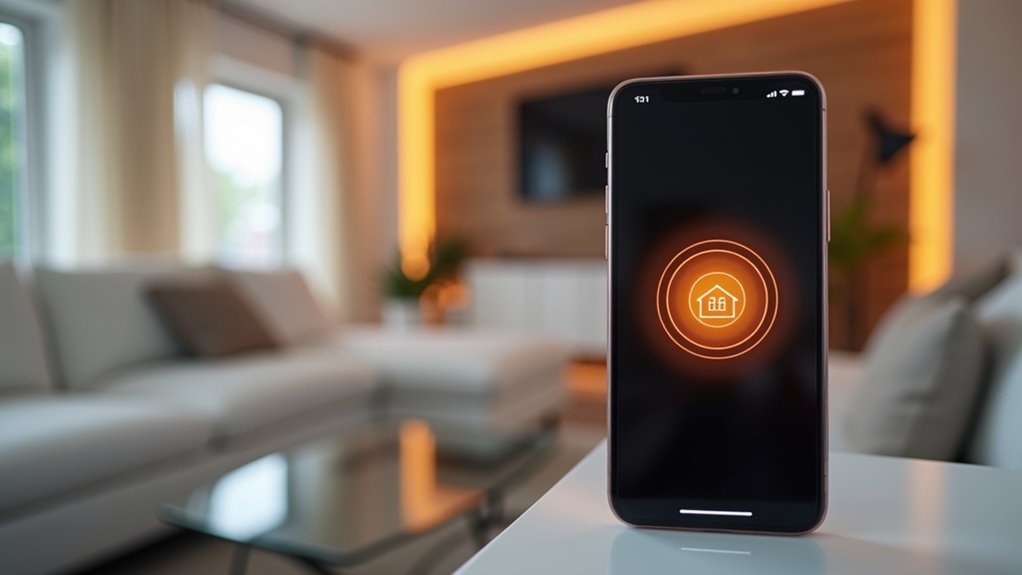
You’ll receive instant notifications on your smartphone whenever your motion sensors detect activity, keeping you informed of potential security threats in real-time.
Your mobile app also grants you remote access to live camera feeds, letting you visually confirm what triggered the alert from anywhere in the world.
This connectivity seamlessly integrates with your other smart devices, creating an all-encompassing monitoring system you can control entirely through your phone.
Real-Time Alert Systems
Although traditional motion sensors provide valuable on-site detection, modern systems excel when they’re connected to your smartphone through dedicated mobile apps.
Real-time alerts transform your home security by delivering instant motion sensor notifications directly to your device whenever suspicious movement occurs. This immediate communication dramatically reduces response times, giving you better chances to prevent break-ins or unauthorized access.
You’ll gain remote monitoring capabilities that let you check your property’s status from anywhere. The mobile apps allow you to customize notification settings, ensuring you receive alerts only for relevant activities while avoiding unnecessary interruptions.
Many systems also integrate with security cameras, enabling you to view live feeds alongside motion alerts for enhanced situational awareness and thorough protection.
Remote Camera Access
Remote camera access transforms motion sensor alerts from simple notifications into extensive visual monitoring systems.
When you receive motion notifications on your mobile apps, you can instantly view live video footage from your security cameras regardless of your location. This real-time connectivity provides immediate visual confirmation of what triggered the alert, whether it’s a delivery person, family member, or potential threat.
Your mobile apps enable two-way audio communication, allowing you to speak directly through your security cameras to visitors or deter unwanted intruders.
You can review recorded video footage triggered by motion sensors to thoroughly assess any security incidents. Additionally, integration with smart home systems lets you control lights and locks directly from your phone when motion alerts occur, creating a thorough security response.
Smart Device Integration
When motion sensors integrate with smart devices, you gain instant access to your home’s security status through intuitive mobile apps that deliver real-time notifications directly to your smartphone or tablet.
Mobile app connectivity transforms traditional motion detection technologies into powerful security tools that keep you connected wherever you are. You’ll receive instant alerts when movement’s detected, enabling immediate response to potential threats.
Key benefits of smart device integration include:
- Customizable notification settings that filter alerts based on your preferences and schedule
- Remote monitoring capabilities allowing 24/7 access to your security system from anywhere
- Automated responses that trigger cameras to record or activate smart lighting when motion’s detected
- Historical data access to review past events and analyze security patterns
Enhanced security comes from this seamless connectivity between your motion sensors and mobile devices.
Reducing False Alarms Through Advanced Filtering Technology
False alarms from motion sensors can quickly turn a valuable security feature into a source of frustration, but advanced filtering technology has revolutionized how these devices distinguish between genuine threats and harmless triggers.
Dual-technology sensors combine Passive Infrared (PIR) sensors with microwave detection, requiring both systems to activate before triggering alerts. This greatly improves detection accuracy by filtering out environmental disturbances like wind or temperature fluctuations.
PIR sensors effectively differentiate between human movement and smaller objects like pets, preventing unnecessary notifications.
You’ll also benefit from customizable sensitivity settings that let you adjust detection levels for your specific environment.
Studies demonstrate that homeowners with advanced motion sensors experience notably fewer false alarms, resulting in improved trust and satisfaction with their security systems.
This technology guarantees you’re only alerted when it truly matters.
Energy Efficiency Benefits of Motion-Activated Systems
Motion-activated systems transform how you manage energy consumption by automatically powering devices only when movement’s detected, eliminating wasteful continuous operation.
You’ll experience smart power management through advanced sensors that integrate with your home’s heating, cooling, and lighting systems to optimize energy use based on actual occupancy patterns.
These automated conservation features can slash your utility costs by up to 80% while extending the lifespan of your fixtures and appliances through reduced wear and tear.
Automated Energy Conservation
Energy-conscious homeowners discover that automated motion-activated systems deliver substantial cost savings by eliminating wasteful power consumption.
Motion sensors intelligently manage your home’s energy efficiency by activating devices only when needed and implementing automated shutdown protocols during unoccupied periods.
These smart systems seamlessly integrate with smart home technology to optimize power usage throughout your residence:
- Automatically turn off lights, HVAC systems, and appliances when rooms are empty
- Reduce power consumption by up to 30% on monthly energy bills
- Adjust heating and cooling settings based on real-time occupancy detection
- Extend equipment lifespan through reduced operational wear and tear
Your automated conservation approach minimizes your carbon footprint while maximizing savings.
Motion sensors create an intelligent energy management system that responds instantly to occupancy changes, ensuring you’re never paying for unnecessary power consumption in empty spaces.
Smart Power Management
When you implement motion-activated systems for smart power management, you’ll access remarkable energy efficiency gains that transform how your home consumes electricity.
Motion sensors automatically control your smart lighting, turning lights on only when movement’s detected and switching them off when rooms are empty. This smart automation reduces your electricity bills by 20-30% while cutting unnecessary energy consumption by up to 80%.
You can optimize energy use by connecting motion sensors to thermostats and HVAC systems, ensuring these devices activate only when needed.
The sensors continuously monitor occupancy patterns, providing valuable data that helps you adjust settings for maximum efficiency.
Reduced Utility Costs
Substantial cost savings await homeowners who switch from traditional always-on systems to motion-activated alternatives that consume power only when detecting movement.
Motion sensors deliver impressive energy savings by automatically turning off lights in unoccupied rooms and activating security devices only when necessary.
You’ll experience significant reduced utility costs through strategic implementation:
- 30% electricity reduction – Studies show motion sensor lighting cuts monthly bills substantially
- Smart automation – Lights and appliances activate only when movement is detected
- Remote monitoring – Smart home systems let you optimize energy usage from anywhere
- Automatic shutoffs – Sensors eliminate wasted energy in empty rooms
This intelligent approach to home automation transforms your monthly utility expenses while maintaining comfort and security throughout your property.
Strategic Placement for Maximum Coverage and Effectiveness
Since effective motion sensor placement determines the success of your entire security system, you’ll need to focus on high-traffic zones where intruders are most likely to pass through.
Strategic placement in entryways, hallways, and stairwells maximizes detection capabilities while minimizing blind spots. Install sensors near exterior doors and garages, as these common access points enhance your overall security coverage.
Position Passive Infrared sensors at least 10-15 feet from heat sources to prevent false alarms from non-threatening movements.
Wireless motion sensors offer flexible placement options, allowing you to optimize coverage based on your home’s specific layout.
Consult security experts to assess your property’s unique features and vulnerabilities.
Professional guidance guarantees your sensor placements create thorough protection tailored to your home’s characteristics and potential security risks.
Professional Vs DIY Installation Options
Professional installation offers distinct advantages over DIY approaches when setting up your motion sensor system. Expert installers understand ideal placement strategies that maximize coverage while minimizing false alarms.
They’ll assess your specific security needs and recommend appropriate sensor types based on your home’s layout and environmental factors.
While DIY installation might seem cost-effective initially, it often leads to costly mistakes:
- Improper sensor positioning that creates security gaps
- Incorrect setup causing frequent false alarms
- Need for future professional adjustments or repairs
- Limited knowledge of various motion sensor technologies
Companies like CPI Security provide extensive end-to-end services, including expert assessments tailored to your property.
Professional installers bring technical expertise that guarantees your system functions effectively from day one, ultimately providing better long-term value than DIY alternatives.
Maintenance Requirements for Optimal Performance
While professional installation sets the foundation for your motion sensor system, regular maintenance guarantees it continues protecting your home effectively.
You’ll need to clean sensors regularly and check battery levels for wireless models to verify excellent performance. Test your system bi-annually to confirm everything’s working correctly.
Environmental changes require sensor adjustments too. When you add or remove pets, modify sensitivity settings to prevent false alarms while maintaining accurate detection.
Keep furniture and decorations away from sensors to maximize their detection range.
For persistent false alarms or complex installations, you might need professional maintenance services.
These experts can fine-tune your system and address issues you can’t resolve yourself, verifying your motion sensors operate at peak efficiency and continue providing reliable home security.
Privacy Considerations and Data Security Features
Beyond physical security, your motion sensor system’s digital privacy deserves equal attention. You’ll need to protect personal information while maintaining your home’s safety benefits.
When selecting motion sensors, prioritize these essential privacy features:
- Customizable privacy settings that let you control when motion data is recorded or shared
- Data encryption protocols ensuring secure transmission and preventing unauthorized access
- Regulatory compliance verification to meet local surveillance and data collection laws
- Clear privacy policies from manufacturers detailing data usage and storage practices
Smart home integration can create privacy vulnerabilities, so choose devices with user-controlled settings for notifications and data sharing.
These features help you maintain control over your personal information while enjoying enhanced security benefits from your motion sensor system.
Cost-Effectiveness Compared to Traditional Security Methods
When evaluating security investments, motion sensor notifications consistently deliver superior value compared to traditional protection methods.
You’ll save considerably on operational costs since these systems eliminate the need for constant human surveillance while providing real-time alerts automatically. The cost-effectiveness becomes evident when you consider that homes with motion sensors experience 300% fewer burglaries, reducing theft-related losses and insurance premiums.
Energy efficiency gives you another financial advantage. Motion sensors activate only when detecting movement, dramatically lowering electricity bills compared to continuously operating security systems.
Motion sensors slash energy costs by activating only when movement is detected, unlike always-on security systems.
You’ll find upfront investments more affordable than hiring security personnel or installing extensive surveillance networks. Smart device integration creates automated responses that prevent property damage, maximizing your security investment’s return while minimizing ongoing expenses.
Troubleshooting Common Motion Sensor Notification Issues
Motion sensors deliver outstanding value, but they’re only effective when functioning properly. When your motion sensor technology isn’t working as expected, several common issues might be affecting its ability to detect movement accurately.
Environmental factors often cause the most frustration with false alarms. Here’s how to address typical problems:
- Clean sensors regularly – Dirt and debris can block detection capabilities and cause missed alerts.
- Adjust sensitivity settings – Pets and moving branches trigger unnecessary notifications that need fine-tuning.
- Relocate away from heat sources – Direct sunlight and heating vents interfere with infrared detection.
- Check wireless connectivity – Weak signals cause notification delays, requiring better positioning or range extenders.
Configure your system to send alerts only when armed, preventing constant notifications during daily activities while maintaining security effectiveness.
Future-Proofing Your Home Security With Motion Sensor Technology
While traditional motion sensors provide basic detection capabilities, investing in advanced motion sensor technology guarantees your home security system remains effective against evolving threats.
Modern sensors incorporate dual-technology features that dramatically reduce false alarms while maintaining precise detection capabilities. When you integrate AI-powered motion sensors into your smart home setup, you’ll benefit from intelligent activity recognition that distinguishes between intruders and harmless movements.
AI-powered motion sensors intelligently distinguish between genuine threats and everyday household movements, virtually eliminating frustrating false alarms.
These advanced features enable seamless connectivity with other home devices, providing real-time notifications and automated responses.
You’ll also enjoy improved energy efficiency since these sensors only activate when they detect motion, reducing operational costs.
With customizable privacy settings, you maintain complete control over your monitoring preferences while future-proofing your home security against tomorrow’s challenges.
Frequently Asked Questions
Why Do People Have Motion Sensors in Their House?
You install motion sensors to enhance your home’s security by detecting unauthorized movement and sending real-time alerts to your smartphone, while also automating lights and coordinating responses with other smart devices.
What Is the Main Purpose of a Motion Sensor?
You’ll find that a motion sensor’s main purpose is detecting physical movement in designated areas. It identifies when someone enters your property, triggering alerts to help you respond quickly to potential security threats.
Are Motion Sensors Necessary?
You don’t absolutely need motion sensors, but they’re highly recommended. They’ll reduce your burglary risk by 300%, provide instant threat alerts, and integrate seamlessly with smart home systems for automated security responses.
What Are the Disadvantages of a Motion Sensor?
You’ll face false alarms from pets and weather, deal with complex installation requirements, handle regular maintenance needs, worry about privacy concerns, and invest significant upfront costs for quality sensors.

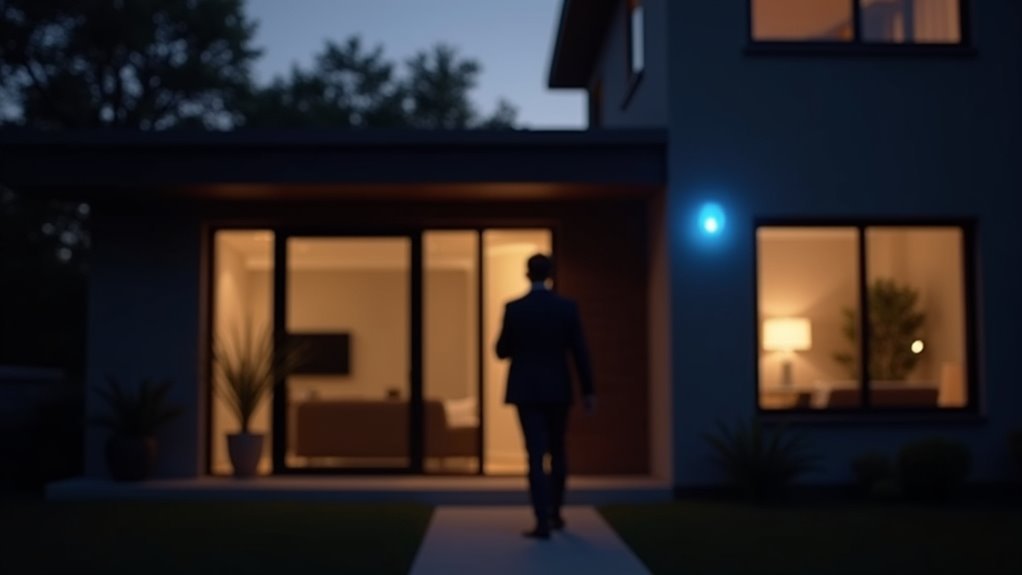
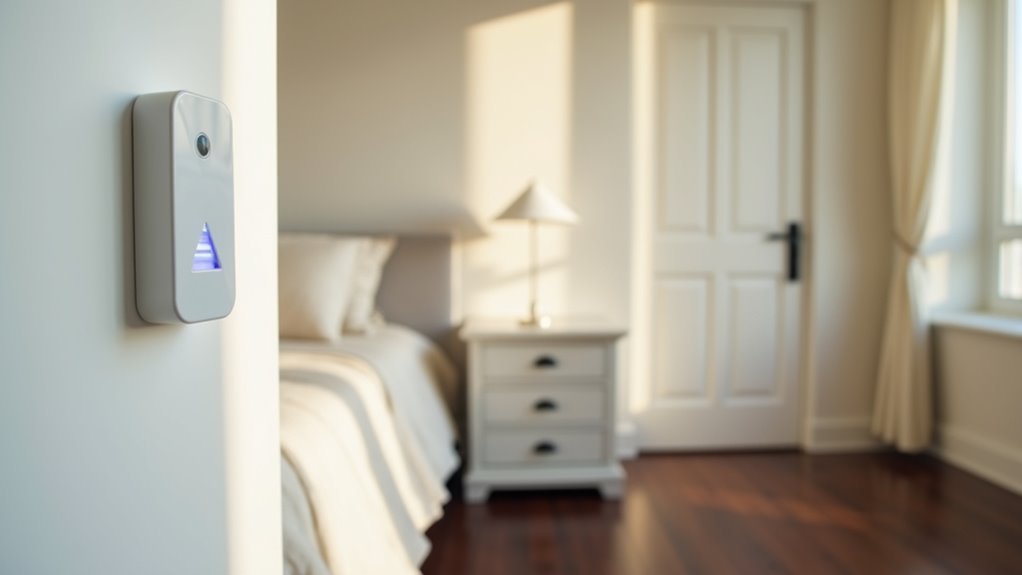
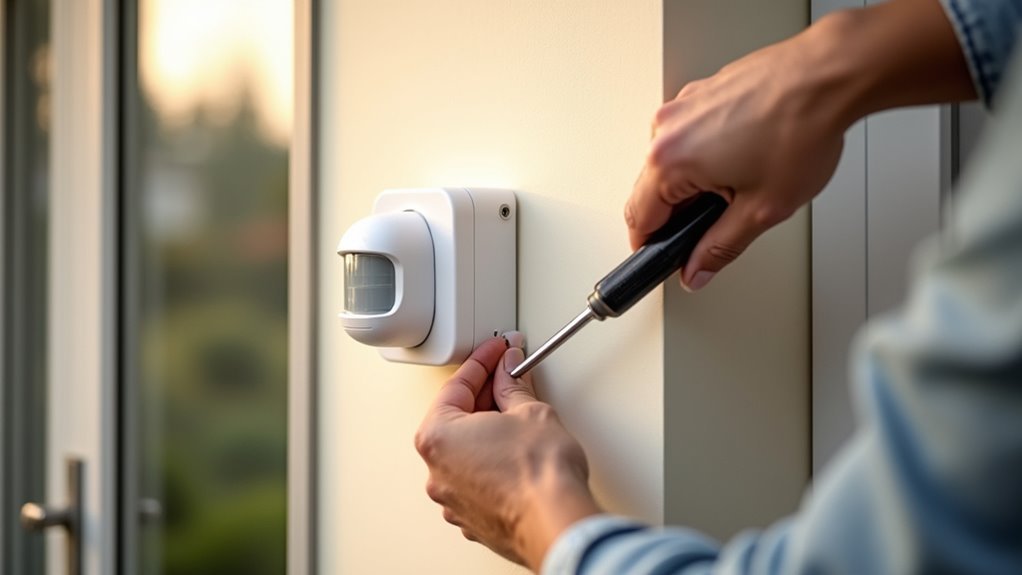
Leave a Reply